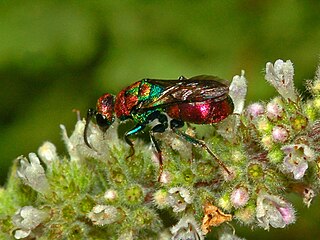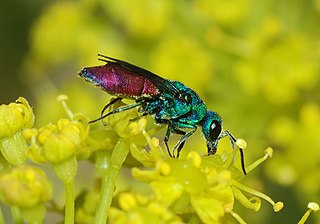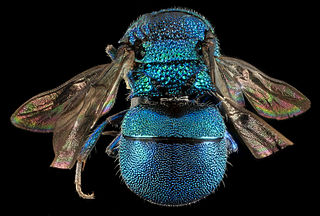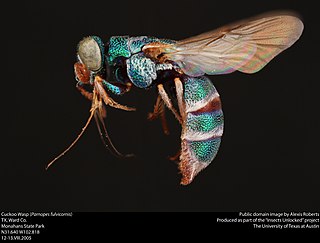
The subfamily Chrysidinae contains those species that are most commonly recognized as cuckoo wasps, being by far the largest and most familiar subfamily. The group contains 3000 species with 48 genera worldwide. They are highly sculptured, with brilliantly metallic-colored bodies, covering the entire spectrum, but primarily blues and greens.

The Euparagiinae are a small subfamily of rare wasps in the family Vespidae containing a single extant genus Euparagia. The group had a cosmopolitan distribution in past geological times extending back to the Early Cretaceous, but is now a geographically relict taxon known only from the desert regions of the Southwestern United States and northwestern Mexico.
Lynn Siri Kimsey is an entomologist, taxonomist, director of the Bohart Museum of Entomology and professor of entomology at the University of California, Davis since 1989. Her specialties are bees and wasps; and insect diversity and evolution.

Chrysis is a very large genus of cuckoo wasps. It is the largest genus in the family, including over 1,000 species in over 20 subgenera, as speciose as all remaining Chrysididae combined. The generic name is derived from Greek chrysis, "gold vessel, gold-embroidered dress", and pays tribute to the brilliant metallic appearance of wasps in the genus.

Chrysidini is a very large tribe of cuckoo wasps in the subfamily Chrysidinae; this tribe contains more than half of all chrysidid species.

Hedychrum is a large genus of cuckoo wasps. With roughly 150 species, it is the second largest genus in the family; most species are from the Palaearctic, but they can be found in the Oriental, Afrotropical, Nearctic, and Neotropical regions. Their hosts are typically from the subfamily Philanthinae.

Chrysura is a genus of cuckoo wasps which parasitize megachilid bees. There are 117 species in Chrysura, all but 11 of which are found in the Palaearctic, making it the third largest genus in the family. The genus was described by Dahlbom in 1845, and the type species for the genus is Chrysura austriaca.
Pleurochrysis is a genus of cuckoo wasps from the New World, with 36 species distributed from Mexico to Argentina. One species is a parasitoid of the potter wasp Cyphomenes anisitsii.

Holopyga is a genus of cuckoo wasps.
Chrysis provancheri is a species of cuckoo wasp in the family Chrysididae.

Elampini is a tribe of cuckoo wasps in the family Chrysididae.

Chrysura simplex is a species of cuckoo wasps, insects in the family Chrysididae.

Amiseginae is a subfamily of cuckoo wasps in the family Chrysididae. There are more than 30 genera and 150 described species in Amiseginae. The group occurs worldwide, and they are parasitoids of stick insect eggs (Phasmatodea). Females of some genera are flightless and resemble ants.

Loboscelidiinae is a small subfamily of cuckoo wasps in the family Chrysididae. There are 2 genera and more than 40 described species in Loboscelidiinae, and they are parasitoids of walking stick eggs.
Elampus cecchiniae is a species of wasp in the cuckoo wasp family (Chrysididae). The species was first described in 1967 by A. P. Semenov-Tian-Shanskij as Notozus cecchiniae and transferred to the genus Elampus in 1991. The holotype is a male that was found in Turkmenistan.

Omalus is a genus of cuckoo wasps in the family Chrysididae.

Omalus aeneus is a species of cuckoo wasps belonging to the family Chrysididae.

Euparagia is a genus of wasps in the family Vespidae, the only extant genus in the subfamily Euparagiinae.

Parnopini is a small tribe of cuckoo wasps in the family Chrysididae. There are 3 genera and about 20 described species in Parnopini; only the hosts of one genus (Parnopes) are known, and they are in the Crabronidae.

Cleptinae is a small subfamily of cuckoo wasps in the family Chrysididae. There are 3 genera and almost 100 described species in Cleptinae, and they are parasitoids of prepupal larvae of tenthredinoid sawflies.















